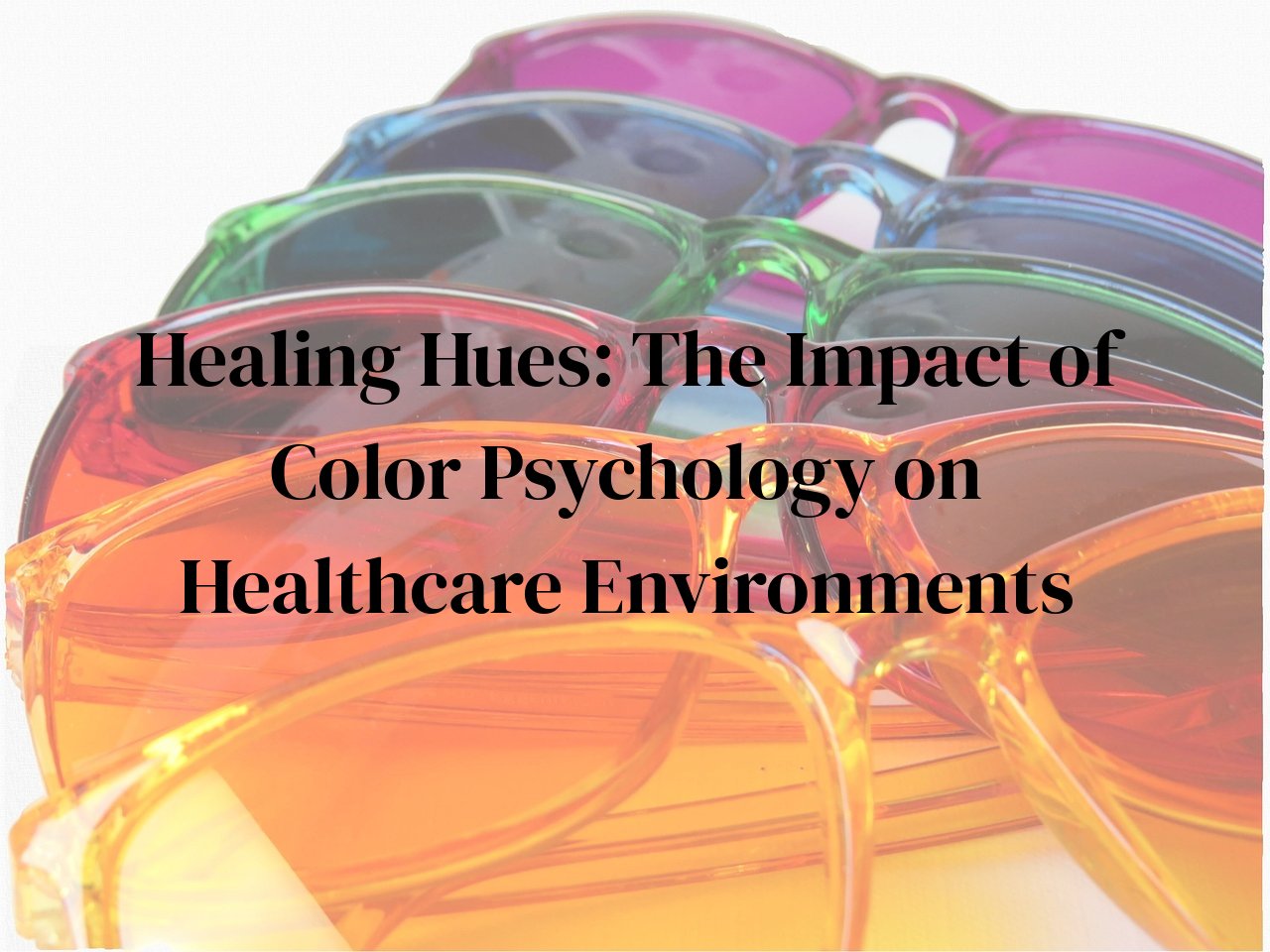
Have you ever noticed how certain colors make you feel a specific way when you enter a room? This post delves into the fascinating realm of color psychology and its significant effects on healthcare environments. From calming blues to energizing greens, the colors within a healthcare setting can profoundly impact patient recovery and staff well-being.
By reading this post, you’ll discover how different hues can influence mood and behavior, and gain insights into how healthcare facilities strategically use color to enhance their environments. Whether you’re a healthcare professional looking to improve your workplace or just curious about the subject, this information could benefit you immensely.
Table of Contents
The Science Behind Color Psychology in Healthcare
Color psychology is a fascinating and ever-evolving field that delves into how different hues can affect human emotions, behaviors, and physiological responses. In healthcare environments, the application of color psychology can significantly impact patient well-being, staff efficiency, and the overall atmosphere of a facility.
The fundamental premise of color psychology is rooted in how various colors influence the human brain. Colors are perceived through the eyes, which send signals to the brain’s hypothalamus, impacting our emotional and physical state. For instance, blue is often associated with calmness and serenity, while red can evoke feelings of urgency and excitement.
Research has shown that color can also affect physiological responses such as heart rate, muscle tension, and overall stress levels. A study from the Journal of Advanced Nursing revealed that colors like blue and green can reduce heart rate and muscle tension, aiding in relaxation and stress reduction, which is crucial for patients in recovery.
Moreover, color psychology isn’t just about the hues. The saturation and brightness of a color can alter its impact. For example, soft, muted colors tend to be more calming and soothing, whereas bright, saturated colors are more stimulating. This is why many hospitals use a combination of colors to create an environment that is both functional and therapeutic.
From a personal experience, I recall visiting a hospital that had strategically used greens and blues in their patient rooms and common areas. The calming atmosphere was palpable, making the stressful experience of being in a healthcare facility significantly more bearable.
Additionally, it’s essential to consider cultural and personal associations with colors. In some cultures, white is associated with purity and cleanliness, while in others, it may symbolize mourning. Therefore, healthcare facilities must consider their patient demographic when selecting colors.
Lastly, the science of color psychology extends to staff performance as well. Energizing colors like yellow and orange can boost morale and productivity among healthcare workers, creating a more efficient and positive working environment.
In summary, understanding the science behind color psychology in healthcare is crucial for creating environments that promote healing, reduce stress, and enhance overall well-being. By leveraging the power of color, healthcare facilities can transform not only their aesthetic appeal but also their functional efficiency.
Calming Colors: Creating a Healing Atmosphere
In my years of exploring the enigmatic world of color psychology in healthcare, I’ve seen firsthand how certain hues can create a milieu conducive to healing and tranquility. The gentle embrace of greens and blues, for instance, can seemingly wash away the anxieties of patients, offering them a sanctuary of peace and calm.
Green, often associated with nature and growth, has a unique way of restoring balance. It can soothe the minds of patients by mimicking the serene expanse of flora, thus fostering a semblance of connection to the outside world. I’ve seen waiting rooms and patient corridors bathed in calming shades of green, transforming them into sanctuaries that soften the long and often stressful waits.
Blue, with its association to the sky and the sea, evokes a sense of stability and depth. When carefully chosen, various shades of blue can convey a sense of professionalism while still offering comfort, making it a preferred option in treatment rooms and patient suites. During my visits to oncology units adorned with soft blue palettes, I’ve observed a noticeable ease among patients, as if the particular hue alleviates the emotional weight of their conditions, if only a little.
Lavender and soft yellows, though less traditional choices, have also demonstrated profound effects. Lavender imbues the environment with a touch of elegance and serenity, subtly encouraging relaxation. I recall one particularly enchanting pediatric ward that used light lavender walls coupled with whimsical artwork. The children seemed more relaxed, their trepidation mitigated by this soothing backdrop.
Meanwhile, soft yellows can exude warmth and comfort, gently invigorating patients without overwhelming them. Properly used in family rooms and recovery areas, this color can lend a sense of coziness and optimism, crucial elements in the healing process.
It’s vital to remember that color interactions can be complex. Sometimes, combining calming hues can amplify their effects. Accents of soft white or beige can break the monotony, preventing any one color from becoming overwhelming. Strategic use of natural light can further enhance the chosen palette, as I’ve seen in sunlit rehabilitation centers where the synergy of light and color creates a truly restorative atmosphere.
Energizing Hues: Boosting Morale and Activity
Have you ever noticed how a splash of bright color can instantly lift your spirits? In the same way, hospitals and healthcare environments can harness the power of energizing hues to boost both patient and staff morale. Picture a children’s ward bathed in vibrant yellows and cheerful oranges. These colors are not random choices; they are meticulously selected to catalyze energy, happiness, and upliftment.
Colors like red, orange, and yellow are often regarded as ‘energizing hues’ due to their ability to spark activity and dynamism. Red, for example, is a high-energy color that can elevate heart rates and induce excitement. In healthcare settings, red can be strategically used in rehabilitation centers where patients need that extra motivation to engage in physical activities.
Similarly, orange emanates warmth and enthusiasm. Studies have shown that this color can help mitigate feelings of sadness and can be particularly effective in communal areas where social interaction is encouraged. As someone who has been involved in healthcare consulting, I’ve seen firsthand how introducing orange accents in dining areas encourages patients to leave their rooms, fostering a sense of community and promoting social engagement.
Yellow, the color of sunshine, is often associated with happiness and mental clarity. Experts recommend its use in cognitive rehab areas where patients are working on mental tasks, as it can enhance concentration and stimulate intellectual activity. During one of my visits to a pediatric hospital, I observed a playroom illuminated with soft yellow light. The atmosphere was visibly cheerful, feeding the children’s zest for play and creativity.
It is crucial to balance these energetic colors so they do not become overwhelming. For example, a bright red wall in a waiting area could induce anxiety instead of comfort. Here, the principle of harmony comes into play. Using energizing hues as accent colors or in combination with calming shades like greens and blues can create an environment that is lively yet soothing.
Color psychology isn’t just about aesthetics; it’s about creating environments that cater to emotional and physical well-being. By incorporating energizing hues, healthcare facilities can turn mundane spaces into vibrant areas where healing and activity go hand in hand.
Considerations in Color Selection for Different Healthcare Areas
Designing healthcare environments with color psychology in mind is a multidimensional task that requires thoughtful consideration of each specific area within a facility. In my years of observing and researching the impact of colors on patient wellbeing, I have come across several important aspects to consider when selecting colors for various healthcare spaces.
Firstly, let’s talk about patient rooms. These spaces should prioritize comfort and tranquility. Soft blues and greens are often recommended as they evoke a sense of calm and serenity, helping to reduce anxiety and promote relaxation. My own experience has shown that patients frequently report feeling more at ease in rooms with these hues. On the other hand, overly vibrant or aggressive colors like red can be stimulating and may even elevate stress levels, thus they should be used cautiously if at all.
Next, we have waiting areas, which are crucial as they serve as first impressions for visitors and patients. Neutral tones such as beige or light gray can be very effective here, offering a serene and welcoming ambiance. Adding splashes of cheerful colors, like yellow or pastel shades, can lift moods and reduce the perceived waiting time. Over the years, I have noticed that such color schemes contribute to a positive and less intimidating environment.
Operating rooms are another critical area where color selection plays a vital role. Traditionally, these rooms have utilized shades of green or blue as these colors provide a stark contrast to the reds and pinks of human tissue, which aids surgeons in their tasks. Furthermore, these colors are known to reduce glare from bright lights and minimize eye strain, enhancing the concentration and performance of the medical team.
Then we have pediatric units, where the objective is to create an inviting and cheerful atmosphere that can distract and comfort young patients. Bright, playful colors like warm oranges, vibrant yellows, and even accent wall murals with cartoon characters can transform a clinical setting into a more familiar, fun, and less daunting space for children. I’ve seen firsthand how such environments make a significant impact on alleviating the fears of young patients.
Finally, staff areas should not be overlooked in terms of color considerations. Spaces like break rooms and offices should incorporate soothing and refreshing colors like light blues or greens to help staff relax and recharge. A touch of yellow can also inspire energy and creativity, making these areas both restorative and motivating. I have often recommended these color choices based on feedback from healthcare professionals who express a need for escapism from the intensity of their work environments.
In conclusion, thoughtful color selection tailored to the specific needs of different spaces within a healthcare facility can significantly enhance patient comfort, staff performance, and the overall healing environment. My journey in observing and advising on the use of color in healthcare settings continually reinforces the profound impact that color choices have on both physical and emotional wellbeing.
Case Studies: Successful Implementations of Color Psychology in Hospitals
One of the most compelling examples of the successful application of color psychology in healthcare settings is the Royal Children’s Hospital in Melbourne, Australia. This facility has fully embraced the potential of color to transform spaces and promote healing. Vibrant yet soothing colors have been meticulously chosen to ensure that young patients feel safe and comfortable. The use of bright blues and greens in the waiting areas creates a calming environment, crucial for easing the anxiety of both children and their families. I had the chance to visit this hospital, and the atmosphere was palpably more serene. Parents I spoke to frequently commented on how the environment eased their stresses.
Another noteworthy case is the Cleveland Clinic in Ohio, USA. Here, color psychology is harnessed to facilitate wayfinding and create purposeful design elements in various departments. For example, the cardiac unit prominently features soothing blue hues, which have been scientifically shown to lower blood pressure and heart rates. In contrast, the pediatric ward employs playful and vibrant colors to stimulate and engage young minds. This stratified use of color is not only visually appealing but also functionally significant. During a tour, the staff shared that patient satisfaction scores have markedly improved since these changes.
The Färgriket Senior Care Facility in Sweden offers another sterling example. This care home has implemented a color-coded system to help residents navigate the space effortlessly. Each floor is distinguished by its own color scheme, simplifying wayfinding for elderly residents who may have cognitive impairments. The facility opted for warm, inviting colors in communal areas to encourage social interaction and a sense of community. Redressing the common areas in yellows and oranges, they observed an encouraging rise in social interactions and a sense of well-being among residents.
I also can’t help but mention Singapore’s Ng Teng Fong General Hospital, which has been hailed as a beacon of modern healthcare design. The architects and interior designers worked closely with color psychologists to enrich patient experiences proactively. Natural colors like earth tones and greens dominate the landscapes and patient rooms, fostering a sense of connection with nature that aids in mental and emotional healing. The staff reported noticeable improvements in patient recovery times and mood metrics.
Finally, the United Kingdom’s Sheffield Children’s Hospital provides another enlightening case study. Known for its colorful and imaginative interiors, the hospital employs color psychology to both mitigate stress and inspire creativity among young patients. Bright murals adorn the walls, and each treatment room has a unique color theme, transforming the typically sterile hospital environment into a more engaging and less intimidating space. During a virtual tour last year, the administrators shared numerous heartwarming anecdotes about the positive patient feedback they’ve received.
Conclusion
In summary, the strategic use of color psychology in healthcare environments is more than just a design choice; it’s a crucial component for enhancing patient care and staff efficiency. By understanding the impact of different colors, healthcare facilities can create atmospheres that promote healing and well-being. The next time you walk into a hospital and feel an inexplicable sense of calm or energy, you can thank color psychology for that experience.



